Chinese water dragons are incredible lizards that deserve more recognition within herpetoculture.
It’s no wonder the Indo-Chinese water dragon (Physignathus cocincinus), or simply “Chinese” water dragon is regularly sought after within herpetoculture: bright green coloration with an array of blue stripes, yellow highlights, and occasional pink tones along the lower chin-shield scales, who wouldn’t want one?!
My passion for water dragons began with a desire for another dragon species, the Philippine sailfin dragon, Hydrosaurus pustulatus. However, the smaller size and calmer demeanor of a water dragon drew me toward working with the species.
After multiple experiences through trial and error and advice from fellow keepers, I can say that today I have produced many water dragons through consistent captive breeding. It is my hope that by sharing my knowledge and experiences with this species, I can promote others to work with them and encourage responsible breeding efforts. Increased captive breeding would reduce the demand of imported animals and instead supply the reptile industry with hassle free, healthy captive born and bred specimens.
Natural History
The Indo-Chinese water dragon (also referred to as the Asian water dragon, green water dragon, or simply: “water dragon”) hails from Cambodia, Laos, Thailand, and Vietnam with some populations occurring within Southern China (Stuart et al. 2019). The common name of the species, Indo-Chinese, references the region of Vietnam, Laos, and Cambodia which were previously referred to collectively as French Indochina. This is where the species is most prevalent (Van Hoang et al. 2018).
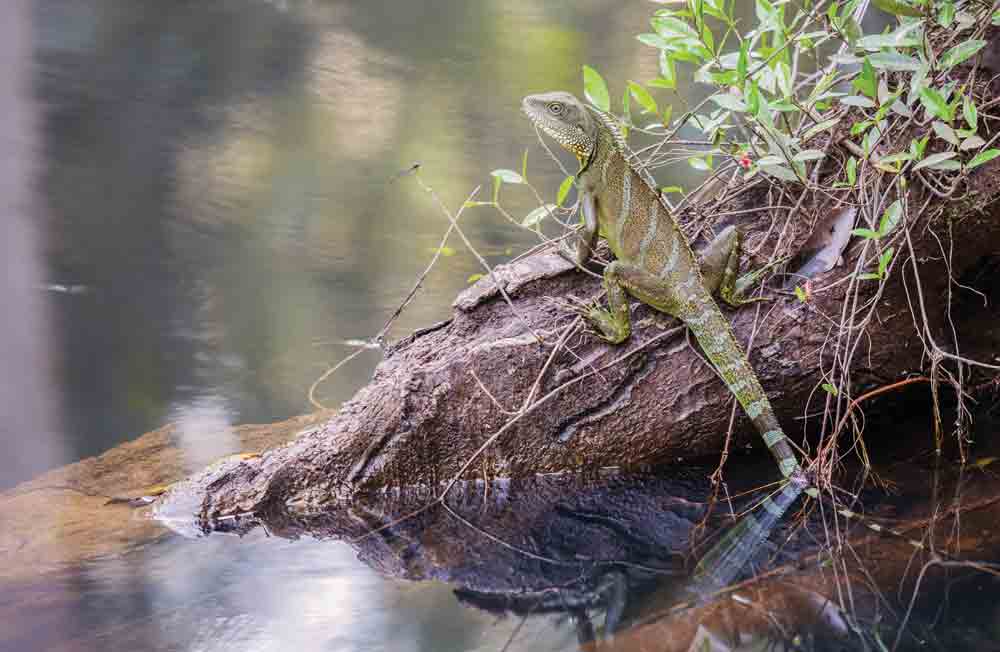
Within their native range, the Chinese water dragon inhabits riparian environments. Photo by Kongsak Sumano/Shutterstock
Many reptile keepers will simply refer to the lizard as the Chinese water dragon which is arguably misleading since this species has minimal native presence in the country of China. Although there is an established population within Hong Kong, this population is the result of introduced specimens that are not of native origin (Mo, 2019).
Asian Water Dragon Born Via Parthenogenesis At Washington’s National Zoo
Within their native range, they inhabit riparian environments (Nguyen et al. 2018). Elongated toes, pointed nails, and well-developed hind and forelimbs offer this lizard the perfect assets to accompany its semi-arboreal lifestyle in the trees. The strong hind limbs offer this species the capability to run bipedally to escape predators. The tail, which can make up to 3/4 the total length of the lizard, acts as a balance to assist it in perching and climbing through trees. Lower regions of the tail are laterally compressed which aids in swimming in the event they need to dash away from predators and make a quick dive into the water bodies which they closely reside.
Between 2010 and 2018 in Europe, 62,962 Chinese water dragons were imported for the sole purpose of supplying the international pet trade (Gewiss et al. 2020). Where are the thousands of adults? Why do we not see hundreds of keepers with healthy and mature specimens like we do with bearded dragons and crested geckos? The sad reality is that despite their low-price tag, water dragons are a difficult species to maintain in captivity. Thus, they are frequently killed in captivity by inexperienced keepers who purchase them. Keeping water dragons in captivity is best left to experienced keepers with adequate resources, space, and time to provide proper husbandry.
Chinese Water Dragon Enclosure Recommendations
Despite being a medium-sized lizard, they are incredibly active and will require custom built or manufactured enclosures. I maintain my adults in large, solid-sided enclosures that vary between four to six feet long, four to six feet high, and two to four feet deep. Enclosures are constructed of PVC sheets or plywood which is sealed with multiple heavy coats of water-based polyurethane to prevent the wood from rotting. There are no screen sections on the tops of my enclosures, allowing me to maintain the high heat and humidity levels this species needs. Ventilation is offered via slits on the sides of the enclosures to promote adequate cross ventilation and fresh air exchange. The front of the enclosure is comprised of either sliding glass or swing-out doors. I cover all portions of glass with paper to prevent the dragons from nose rubbing.
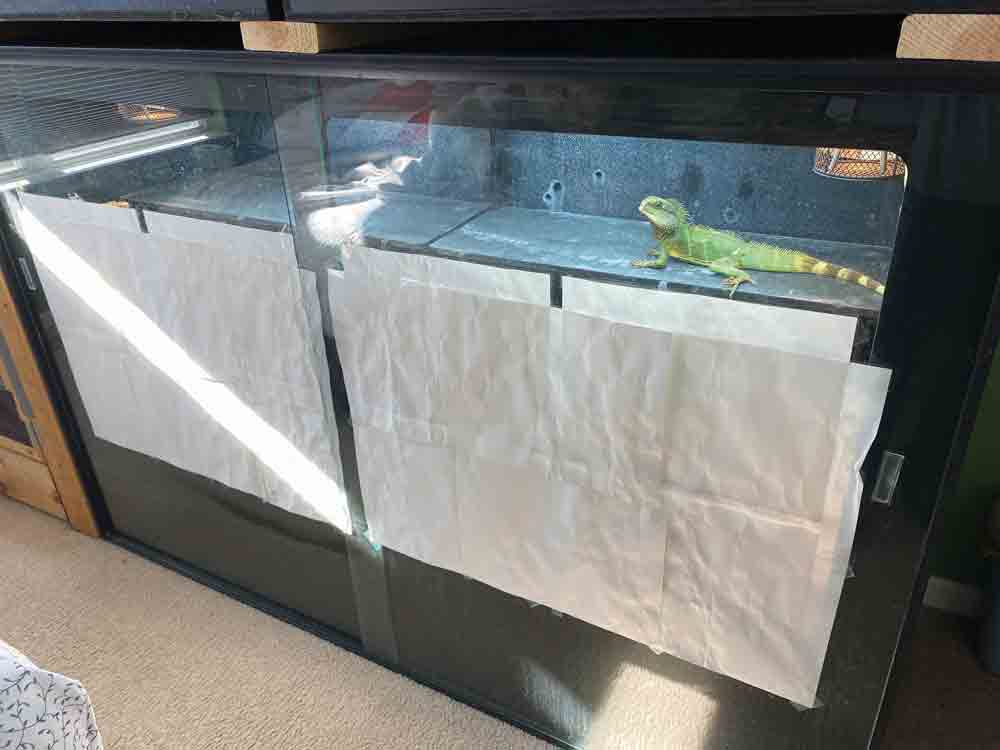
A front view of one of the author’s enclosures. A majority of the transparent side is covered to prevent “nose rubbing” behaviors as water dragons cannot comprehend clear barriers. Photo by Alex Myers
Nose Rubbing
Water dragons are notorious for beating themselves up against transparent barriers when maintained in captivity. Many keepers will blame enclosure size for the nose rubbing behaviors against clear barriers. However, I have found that the best way to prevent nose rubbing in captive water dragons is by using enclosures that are constructed of solid sided materials and built to have minimal viewing areas. Glass, screen, mesh, acrylic, plexi-glass, and any enclosure made from material that is transparent must be avoided entirely as these are inadequate options to maintain water dragons. Using such materials for large viewing areas will only lead to a dragon nose rubbing, or worse: severe rostral abrasions that lead to secondary infections. Therefore, the best way to avoid nose rubbing behaviors entirely is by minimizing the use of transparent barriers, or not providing any at all.
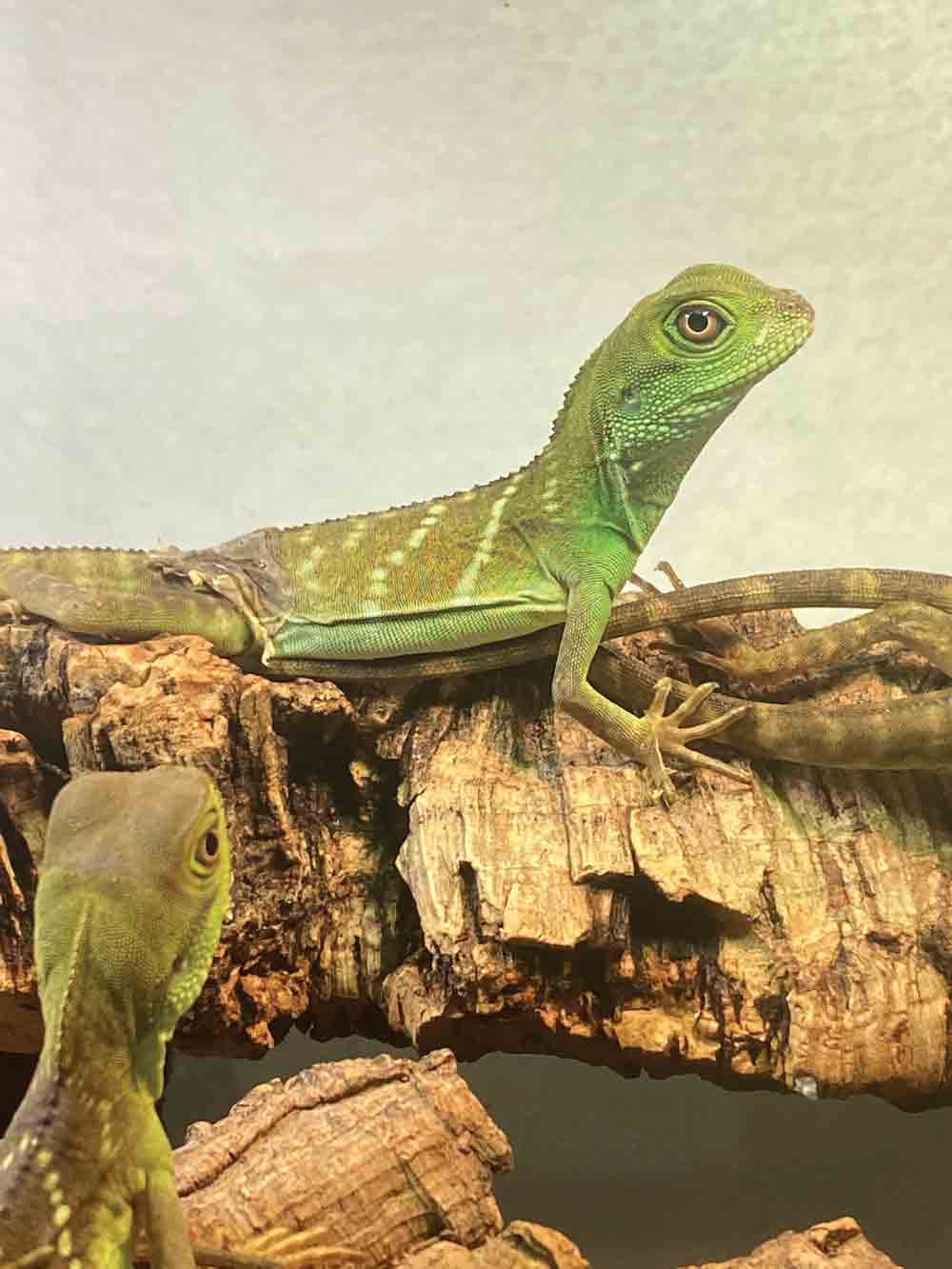
A young water dragon beginning its ontogenetic color change from the typical brown color associated with neonates to the classic green coloration associated with the species. Photo by Alex Myers
An even mix of coconut chips and organic topsoil is my substrate choice for water dragons. This forms a nice humidity holding mixture that can easily absorb excess spray water and offers some cushioning should the lizards jump down to the ground from higher perches. I only use about two to three inches of this substrate because I want to discourage gravid females from laying eggs directly on the cage floor.
Female water dragons should be provided with a large nest box containing six to 12 inches of organic potting soil to offer an ideal spot to lay eggs. By using a nest box, I can ensure that breeding females will lay in a specific area, and I will not miss collecting any eggs after she has laid.
Enclosure décor should consist of large branches and other arboreal perches. I always try to aim for branches that are equal to or slightly larger than the lizard’s bodily girth so they can feel comfortable while perched.
Live or artificial plants can be utilized to create a naturalistic look within the enclosure. I personally choose live plant species that are very hardy and can withstand trampling of dragons such as Pothos (Epipremnum sp.), Arrowhead plants (Syngonium sp.) and Tradescantia sp.
Despite the name water dragon, these lizards spend much of their time in trees. While many utilize large water sources with filtration, I personally choose totes that can be fully cleaned and changed every day. The main reason why I utilize simple water sections is because it allows me to monitor the feces of the dragons to check for any signs of blood, parasites, and any other potential issues that would otherwise be missed if using a filtered setup. Many experienced keepers have kept water dragons successfully this way with no issues pertaining to the long-term captive welfare of the lizards (Langerwarf, 2006). While many keepers claim this species needs moving water, they have no issues recognizing still water in a deep bowl or pan and will eagerly soak, defecate, and shed as they would with a larger water source.
Chinese Water Dragon Heating, Lighting, and Humidity
Water dragons experience warm temperatures year-round. Daytime highs typically peak with ambient air temperatures between 82 to 88 degrees Fahrenheit (27.8 to 31.1 degrees Celsius). Night time temperatures will sit between 70 to 78 degrees Fahrenheit (21.1 to 25.6 degrees Celsius). Throughout my enclosures are multiple basking sites using waterproof outdoor halogen flood lights. Surface temperatures directly under the heat lights range from 95 to 115 degrees Fahrenheit (35 to 46.1 degrees Celsius). The more options you can give them the better.
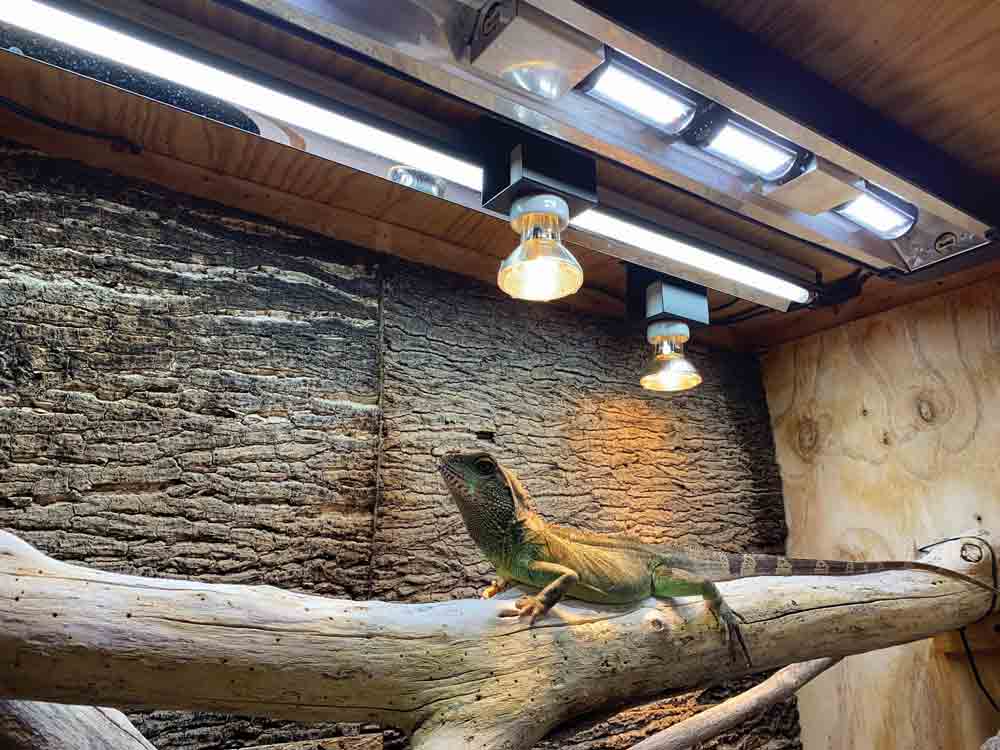
In addition to UVB radiation, water dragons benefit from having multiple basking sites to
regulate their body temperature to their own preference. Pictured is one of the author’s lighting setups with adult female water dragon choosing to bask directly under the heat and UVB lamp. Photo by Alex Myers
UVB radiation from specialty lamps is incredibly important for water dragons as they utilize UVB radiation in their process of metabolizing calcium. High output linear fluorescent bulbs such as the Zoo Med T5HO ReptiSun 10.0 are my go-to bulbs for providing UVB. I place these bulbs next to the heat lamps to ensure that the lizards get both heat and UVB radiation when they bask. Lizards can get within 12 inches from the face of the lamp for ideal UVB exposure. UVB is provided 10 to 12 hours a day depending on the time of year. If these lizards are not given adequate UVB radiation, they are prone to stunted growth and metabolic bone disease, to which severe cases will result in death.
In the wild, water dragons are frequently exposed to high levels of humidity. Enclosures should be heavily sprayed in the morning to achieve levels between 80 to 90 percent relative humidity (RH), mimicking the morning dew or mist of their natural habitat. I’ve found that water dragons will take the opportunity to drink when sprayed with the running water. Enclosures dry out during the day sitting comfortably within levels of 70-80 percent RH. Night time humidity levels rise immensely with the cooling of ambient temperatures. I aim for relative humidity levels of 90 percent or higher. If proper humidity levels are not maintained, dorsal spines will fall off from stuck shed, resulting in captive water dragons never growing the true tall and impressive spines that are frequently exhibited by wild specimens.
Diet in Captivity
In captivity, water dragons will consume a variety of feeder insect species. I primarily feed crickets (Gryllodes sigillatus), Guyana spotted cockroaches (Blaptica dubia) and earthworms (Lumbricus terrestris). I will also supplement other feeders such as super worms (Zophobias morio) and horn worms (Manduca quinquemaculata). It is important to gut-load all insects with fresh, leafy greens and vegetables at least 12 to 24 hours before they are fed to your dragon. This ensures your lizard is getting the best nutrition from the insect as well as the plant material inside the gut of the insect. I offer my adult dragons food every other day.
I supplement all feeder insects with a fine grade calcium carbonate supplement each feeding since many commercial feeder insects are high in phosphorous (Finke, 2013, La’Toya et al. 2017). Use of a multivitamin supplement every other week helps ensure the dragons are getting everything they need nutritionally. Recent studies have shown the absence of fish, mammal, or reptilian prey within the stomach contents of wild water dragons (Van Hoang et al. 2018).
Therefore, I do not suggest following outdated advice of feeding fish, rodent, or reptile feeders to water dragons in captivity. Older literature suggests that captive water dragons are especially prone to fatty liver disease (Köhler, 2006), which could be attributed to misinformed diets consisting of fatty rodents fed in excess.
Water Dragon Captive Breeding, Egg Incubation, and Rearing of Neonates
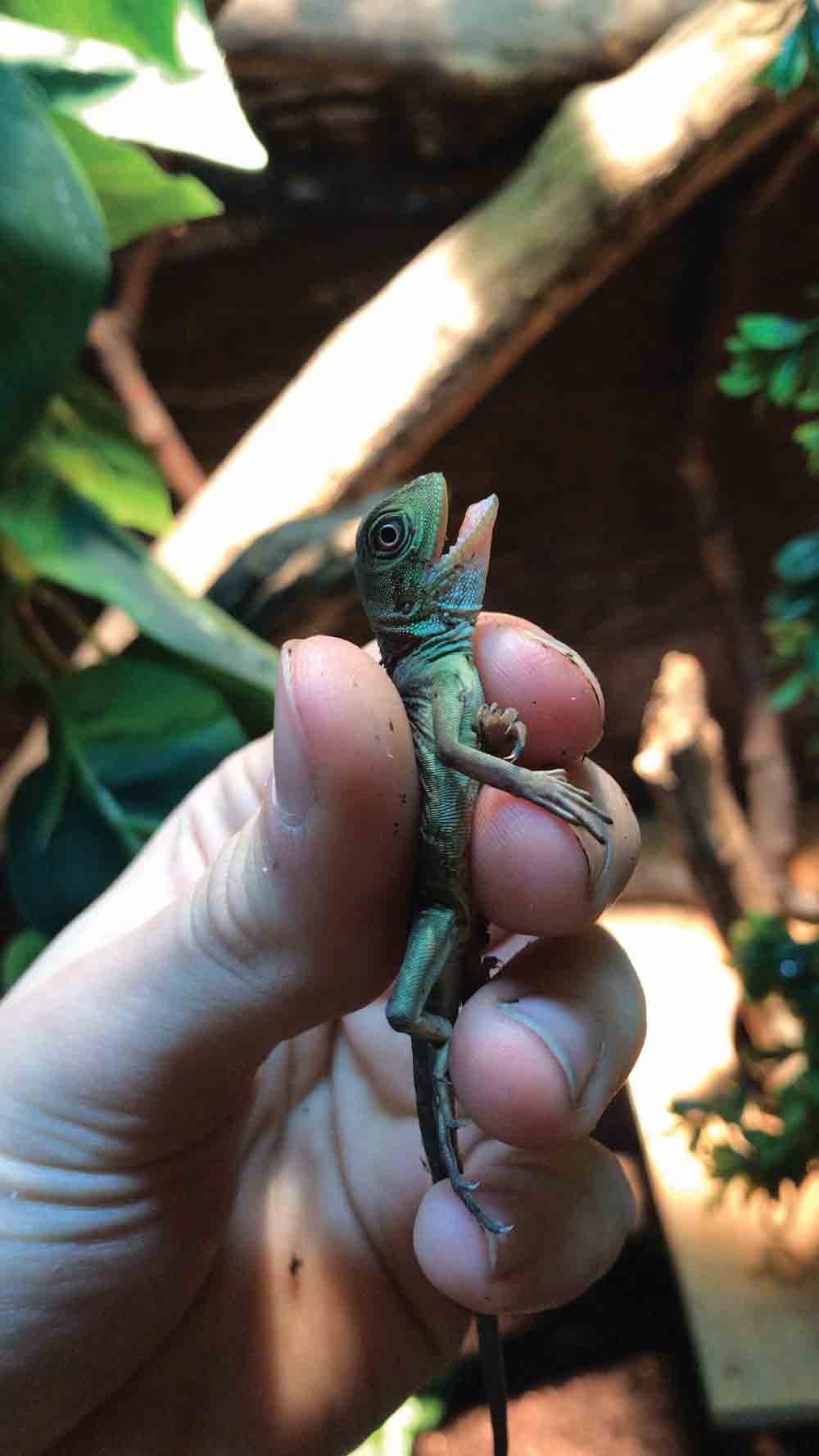
The author holds a young water dragon. Photo by Alex Myers
Water dragons breed prolifically under ideal conditions. Breeding is best triggered by mimicking seasonal changes of their natural environment. I’ve found the best way to trigger this is by reducing the light cycles to 11 hours of daylight in the winter months when enclosures will naturally dry out faster, and 13 hours during summer months as this coincides with the prolonged daylight hours they experience in the rainy seasons. Mating behaviors and copulations start within the middle to end of the dry season and will continue throughout the early onset of the rainy season. Mating is initiated via the male head bobbing rapidly followed by pursuing females to copulate. Males will grasp the female by their nuchal crest, twist their body alongside the female, and then insert one of the two hemipenes into the cloaca of the female for copulation.
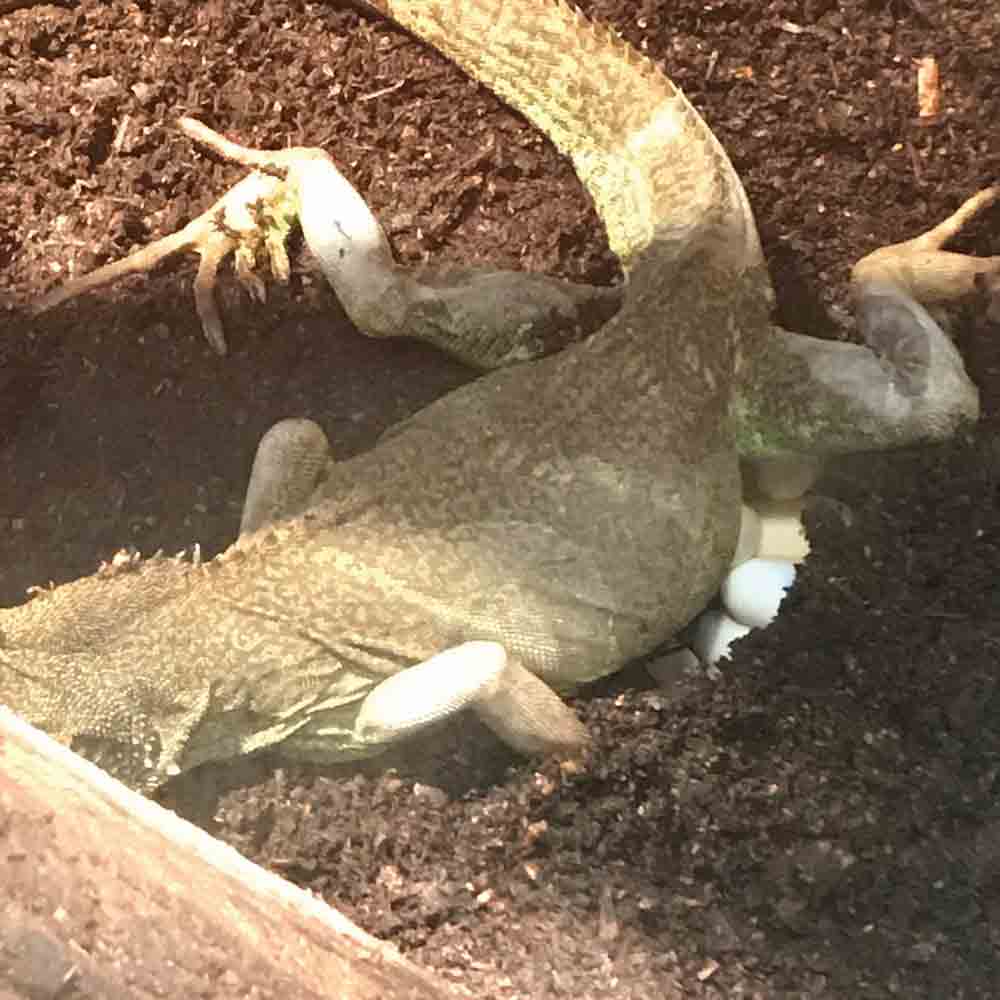
A female water dragon laying eggs. Photo by Alex Myers
Relying on behavioral cues from females will be a keeper’s best insight as to when she will lay eggs. I’ve found females will either increase or decrease their appetite while gravid. It depends on the individual specimen. Females seem to prefer cooler areas of the enclosure and perch on diagonally angled branches (perhaps to distribute the weight of eggs inside them) as eggs grow and develop. The hip bones become more prominent as well as the legs taking on a flabby appearance.
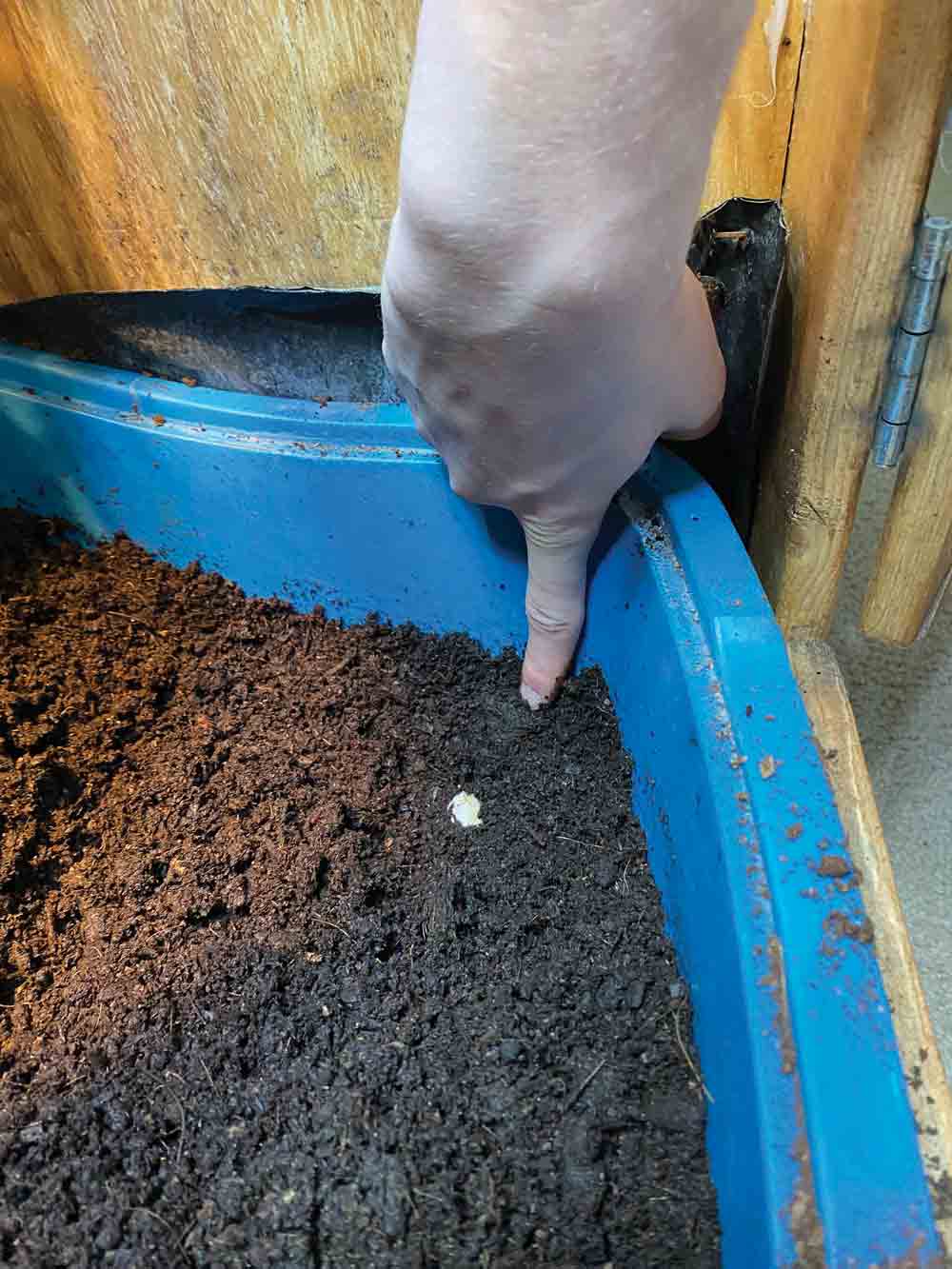
A freshly uncovered nest within a lay box. Photo by Alex Myers
Test holes in the nest box may occur prior to a female laying, though I have also experienced some females never showing interest in a nest box while gravid. Healthy female water dragons can lay as many as five clutches of eggs in a season, though most will only lay two or three. I have found females average five weeks between clutches with some being slightly longer or shorter by a few days. Clutch sizes average from seven to 14 eggs.
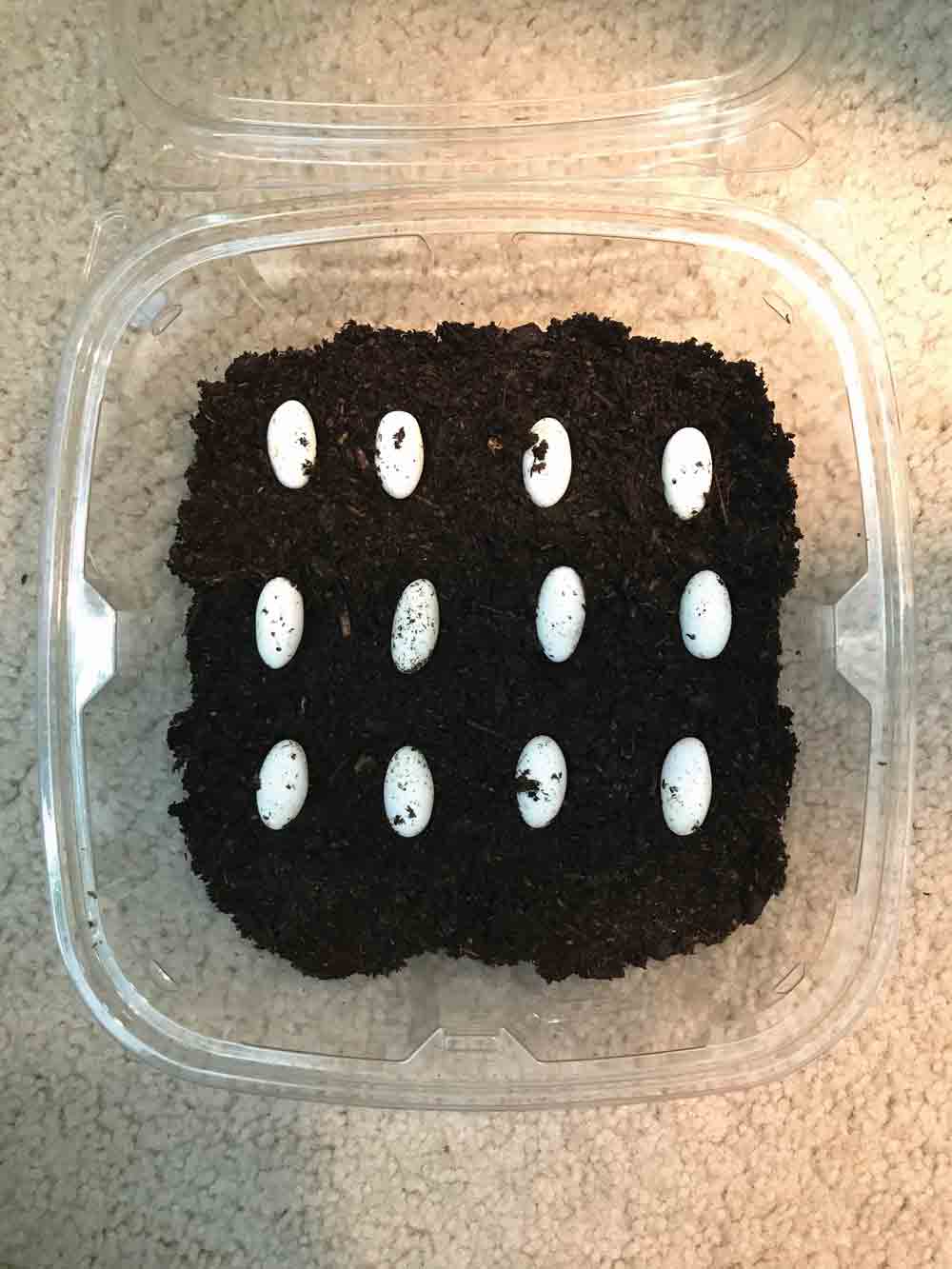
A freshly dug up clutch of eggs, soil and vermiculite is the author’s choice for an incubation medium. Photo but Alex Myers
After I can tell a female has laid by noticeable loss in body weight, eggs are carefully dug up and then placed into plastic containers with dampened soil or vermiculite. Eggs are buried three-fourths of the way into the incubation medium with the tops exposed. I poke two small holes on opposite sides of the container to allow a small amount of cross ventilation. This ensures eggs have enough air exchange throughout the incubation process, while maintaining high levels of air humidity within the container.
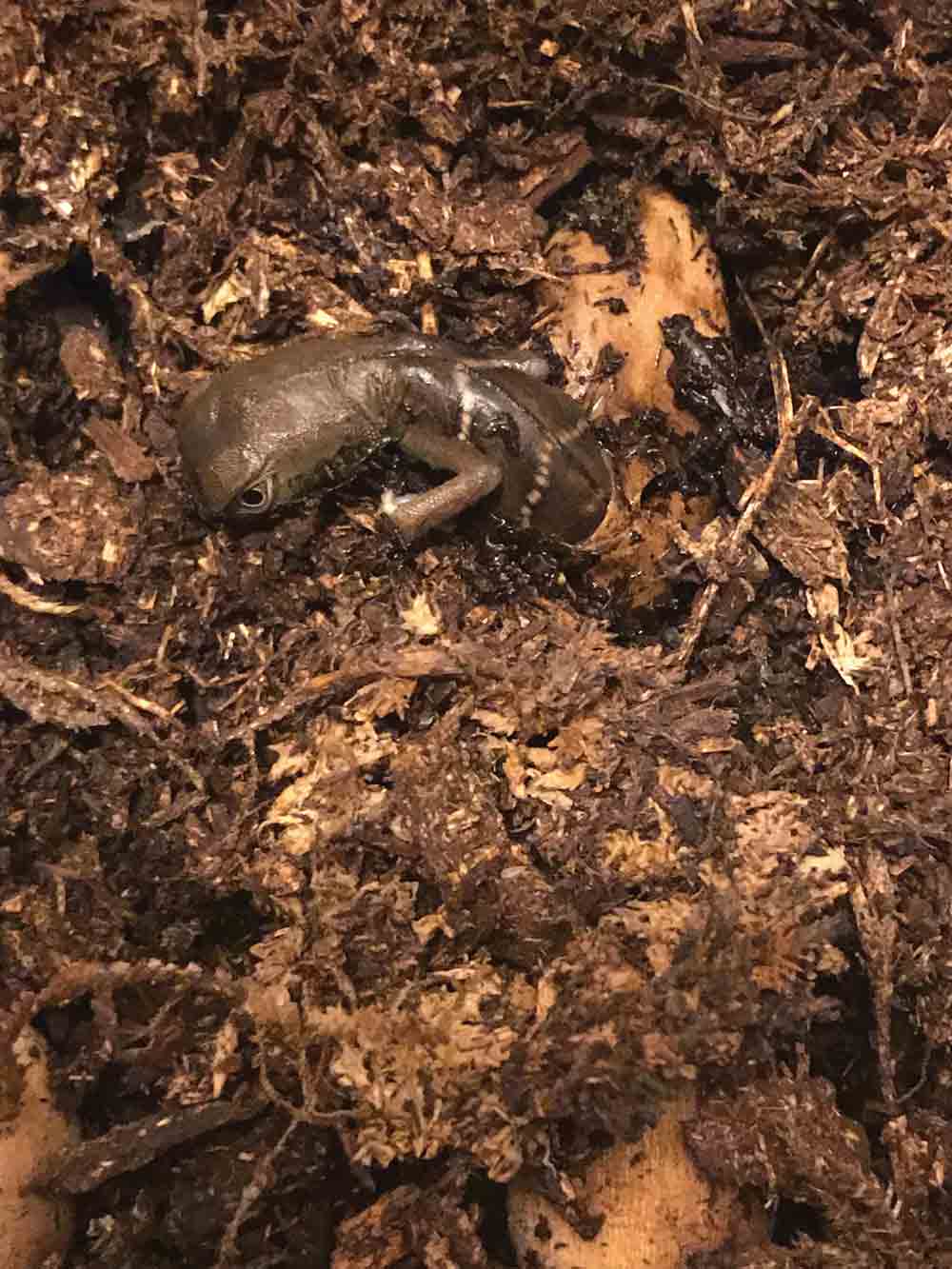
A neonate emerging from its egg in the author’s hand. Fresh soil and vermiculite is the author’s choice for an incubation medium. Photo by Alex Myers
I incubate eggs between 82 to 83 degrees Fahrenheit (27.8 to 28.3 degrees Celsius). At these temperatures, eggs will hatch at just over 70 days.
Older literature suggests temperatures as high as 85 to 88 degrees Fahrenheit (29.4 to 31.1 degrees Celsius) for incubation (De Vosjoli, 1992). I have incubated eggs as high as 85 degrees in the past and while incubating at higher temperatures does result in shorter incubation times, I’ve found that neonates hatched at these temperatures were smaller and slightly more difficult to establish initially compared to eggs that were incubated at cooler temperatures. I suspect that by providing a longer and slightly prolonged incubation at cooler temperatures, the growing embryo can absorb all the yolk within the egg, yielding larger and healthier neonates that are ready to take on the world.
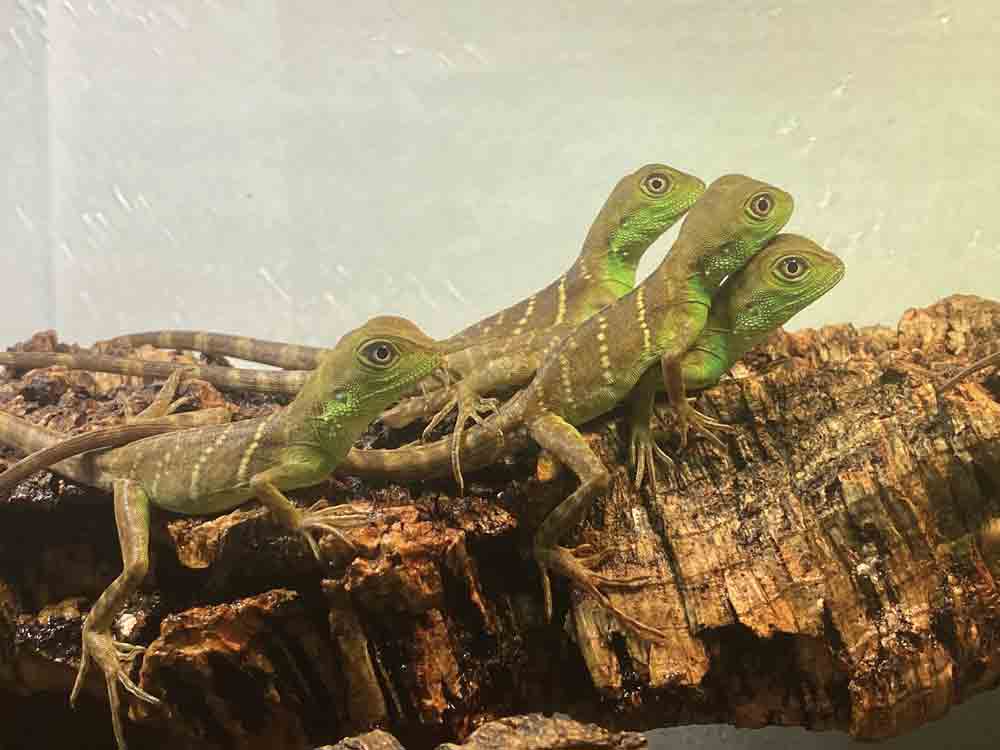
A group of young water dragons basking.
Neonates are raised together in smaller enclosures with the same parameters that I use for adults. I always have spare enclosures should any signs of aggression occur as neonates grow. Like adults, I feed various gut loaded insects dusted with a calcium carbonate supplement. A multivitamin supplement is provided once a week for neonates. I offer food every day by providing a ceramic bowl that is kept constantly filled with feeder roaches. Crickets also work wonderfully for feeding neonates as they move around the enclosure and easily capture the attention of a hungry young dragon. Enclosures are hand sprayed heavily two to three times a day to ensure the dragons have plenty of opportunities to drink. Water bowls must be cleaned daily as the increased metabolism of young water dragons also results in them defecating frequently in their water area. The little dragons grow up quickly, and within three years they will be fully grown, beautiful adults.
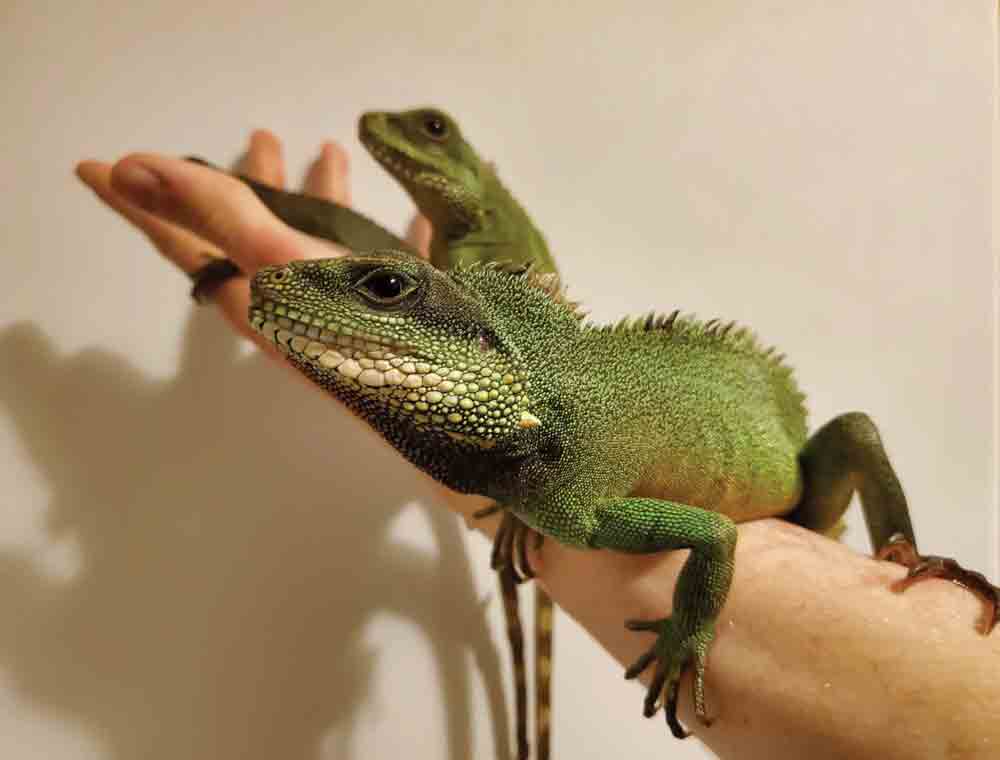
The author holds a young trio of water dragons. The male is in the foreground. Photo by Alex Myers
The Way of the Water Dragon
I hope that the information shared in this article has brought awareness and more appreciation to the Indo-Chinese water dragon. They are incredible lizards that deserve more recognition within herpetoculture. I cannot emphasize enough the importance of captive breeding efforts on behalf of private keepers to ensure this species does not disappear from the reptile industry as many other species have. Until more keepers and large-scale breeders can see the true value of this species, as opposed to focusing only on the cheap price tag that currently plagues imported specimens, I fear that this species may wither away. Perhaps there are those now reading this article who can change that, and pave the way to ensure future keepers will be working with this species as I have.
Alex Myers has worked at numerous public and private facilities caring for and breeding a multitude of reptile and amphibian species. He focuses primarily on Hydrosaurus, Physignathus, and other lizard species within the family Agamidae.
Resources:
- De Vosjoli, Philippe. Green Water Dragons: Plus Sailfin Lizards & Basilisks. Advanced Vivarium Systems Inc. 1992.
- Finke, Mark D. “Complete nutrient content of four species of feeder insects.” Zoo biology 32, no. 1 (2013): 27-36.
- Gewiss, Laurenz Rafael, Hai Ngoc Ngo, Mona van Schingen-Khan, Marta Bernardes, Anna Rauhaus, Cuong The Pham, Truong Quang Nguyen, and Thomas Ziegler. “Population assessment and impact of trade on the Asian Water Dragon (Physignathus cocincinus Cuvier, 1829) in Vietnam.” Global Ecology and Conservation 23 (2020): e01193.
- Köhler Gunther, and Köhler Gunther. Diseases of Amphibians and Reptiles 13 Tables. Krieger, 2006.
- La’Toya, V. Latney, Barbara D. Toddes, Nicole R. Wyre, Dorothy C. Brown, Kathryn E. Michel, and Johanna A. Briscoe. “Effects of various diets on the calcium and phosphorus composition of mealworms (Tenebrio molitor larvae) and superworms (Zophobas morio larvae).” American journal of veterinary research 78, no. 2 (2017): 178-185.
- Langerwerf, Bert. Water Dragons. TFH Publications Inc, 2006.
- Mo, Matthew. “Using citizen-science reports to document range expansion of the introduced Chinese Water Dragon (Physignathus cocincinus) in Hong Kong.” Reptiles & Amphibians 26, no. 2 (2019): 128-131.
- Nguyen, Truong Quang, Hai Ngoc Ngo, Hoang Nguyen Van, Chung Dac Ngo, Mona van Schingen, and Thomas Ziegler. “First population assessment of the Asian Water Dragon (Physignathus cocincinus Cuvier, 1829) in Thua Thien Hue Province, Vietnam.” Nature Conservation 26 (2018): 1-14.
- Stuart, B., M. Sumontha, M. Cota, N. Panitvong, T. Q. Nguyen, T. Chan-Ard, T. Neang, D. Q. Rao, and J. Yang. “Physignathus cocincinus.” The IUCN Red List of Threatened Species 2019 (2019).
- Van Hoang, Nguyen, Ngo Van Binh, Ngo Dac Chung, and Nguyen Quang Truong. “Diet of the Indochinese water dragon Physignathus cocincinus Cuvier, 1829 (Squamata: Sauria: Agamidae) from Thua Thien Hue Province, Vietnam.” Russian Journal of Herpetology 25, no. 3 (2018): 189-194.


